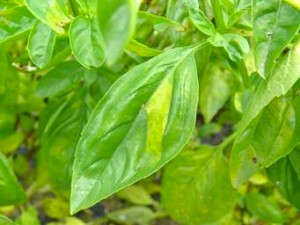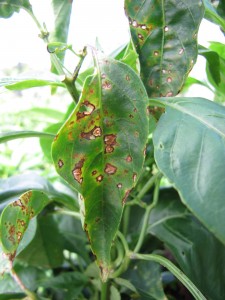Phytophthora blight typically develops in low-lying areas after a heavy rain and can spread quickly throughout the entire field. Fortunately, New Jersey has been really dry this summer, but that does not need you don’t need to prepare for potential Phytophthora issues down the road. This is particularly important if are in fields with a known history of Phytophthora blight. Although the extended period of dry weather works against Phytophthora development, it does not mean it will not show up eventually. [Read more…]
Important resources for pepper disease control
Pepper production is in full swing in New Jersey and the mid-Atlantic region. Below are links to useful resources for the identification and management of important pepper diseases.
Early-season Phytophthora and Pythium control
Preparing for pepper anthracnose
Phytophthora-tolerant and -resistant bell pepper variety trial reports
Survey continuing for bacterial leaf spot and copper resistance in 2021 growing season
Early-season Phytophthora blight and Rhizoctonia root rot control.
Phytophthora blight typically develops in low-lying areas after a heavy rain. Fortunately, this spring in New Jersey has been really dry – too dry thus far, but that does not need you don’t need to prepare for potential phytophthora issues down the road. This is particularly important if are in fields with a known history of Phytophthora blight. Although extended periods of dry weather works against Phytophthora development, it can lead to Rhizoctonia root rot issues in newly transplanted plugs, especially if those plugs remain on the dry side too long before watering. Symptoms of Rhizoctonia root rot appear as brown lesions at the base of the stem with those lesions eventually girdling the stem and extending about an inch above the soil surface. If transplants haven’t been treated the the cell flat prior to transplanting, apply a fungicide through the drip system soon after transplanting. [Read more…]
Specialty Crops Injury Caused by Dicamba Herbicide Drift
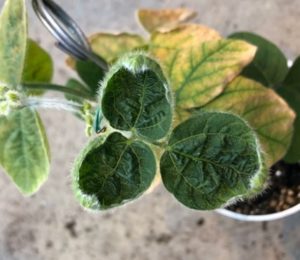
Figure 1. Non-tolerant soybean foliage when exposed to a sublethal rate of dicamba 2 weeks after treatment. Leaves are cupped with the bottom edges curved towards the top surface of the leaves.
By Maggie Wasacz1 and Thierry Besancon2
1 Rutgers Weed Science Graduate Student; 2 Rutgers Weed Science Extension Specialist for Specialty Crops
Glyphosate-tolerant soybeans were first commercialized in 1996 in the United States. By 2006, almost 9 out of every 10 soybean acres were planted with glyphosate-tolerant cultivars. However, reliance on glyphosate alone for soybean weed control stimulates the selection of weed biotypes naturally resistant to glyphosate. By 2019, there were 43 weed species known to be resistant to glyphosate, including species such as Palmer amaranth or waterhemp that can easily out-compete soybean and reduce yield by more than 50% if left uncontrolled.
What is Dicamba Herbicide?
One way to control glyphosate-resistant weeds is to treat them with herbicides other than glyphosate, such as dicamba. Dicamba is a synthetic auxin herbicide that has been used to control broadleaf weeds for over 50 years. Chemical and seed companies have recently developed new soybean varieties that are tolerant to dicamba and that started to be commercialized in 2016. With the development of genetically modified dicamba-tolerant soybeans, dicamba may be sprayed more frequently during the growing season. Additionally, dicamba is regularly applied in corn, for right-of-way applications, and in the early fall for perennial weeds control.
Dicamba can injure sensitive broadleaf plants through tank incorrectly rinsed after spraying dicamba, particle drift during the dicamba application, and vaporization after dicamba has been applied . Particle drift refers to the herbicide being carried off-target by the wind during the application. Wind speed, particle droplet size, nozzle type, carrier volume, application method, and application speed will affect the extent of particle drift. Vaporization, on the other hand, occurs when the herbicide evaporates from the target plant and these vapors travel off-target. For more information on herbicide drift, please refer to the following PPA post 10-best-management-practices-to-avoid-herbicide-drift.
If some of the dicamba sprayed onto a soybean field moves off-target and lands on a nearby field planted with a sensitive crop, the results can be very harmful. This injury could potentially cause aesthetic damage as well as reduce yield reduction. Potential for yield loss is influenced by amount of dicamba as well as when the injury occurs. Small volumes of dicamba products can cause leaf cupping and deformation, plant twisting, and in extreme cases, plant death of sensitive crops.
Screening Vegetables for Dicamba Sensitivity
Greenhouse studies conducted at Rutgers University in 2019-2020 screened economically important vegetable crops from the mid-Atlantic region for sensitivity to sublethal doses of dicamba. These micro-rates of dicamba simulated varying levels of drift conditions in the field. To put the rates into perspective, the highest dose in this study was equivalent to about one drop of product per quart of water. The goals of this study are to develop recommendations that can help growers design their planting strategies around dicamba-treated fields as well as to use this data to help refine recommendations to maximize protection of sensitive crops.
Crop-Specific Reactions to Simulated Dicamba Drift
The most sensitive crops in this study were the leguminous crops, including non-tolerant soybean, lima bean, and snap bean, as well as solanaceous crops, such as tomato, eggplant and pepper. These crops demonstrated severe injury.
Soybean injury is characterized by the underside edges of the leaves curling upward toward the top surface of the leaves (Figure 1). Lima bean and snap bean have similar injury symptoms, both exhibiting injury in several ways. Higher rates caused some leaves to not emerge at all, while lower rates caused leaf cupping injury that caused the top edges of the leaves to curve downward towards the ground. Other symptoms included a bubble-like texture on the top sides of the leaves, as well as leaf crinkling.
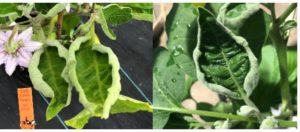
Figure 2. Eggplant 2 weeks after treatment. The undersides of affected leaves are curled upward toward the top surfaces of the leaves.
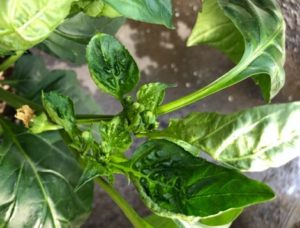
Figure 3. Bell pepper 2 weeks after treatment. The leaves are cupped with a bubble-like texture on the top surface.
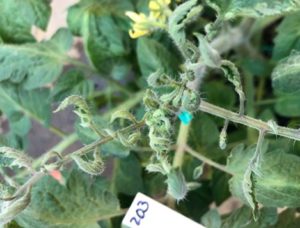
Figure 4. Tomato 2 weeks after treatment. Leaflets are curled, reduced in size, and deformed.
For eggplant and bell pepper, injury was expressed as the undersides of the leaves curling upward toward the top surface (Figures 2 and 3). Additionally, leaf crinkling is seen in bell pepper foliage (Figure 3). Finally, tomato plants express dicamba injury with leaf twisting, cupping, stunting, and crinkling. At higher rates, these leaflets will be extremely stunted and deformed (Figure 4). Lower rates will show slight cupping, leaf crinkling and a change in leaf surface texture. Among the most tolerant crops from this study were basil, pumpkin, lettuce, and kale. These plants incurred the lowest amount of damage. The moderately sensitive crops included watermelon, cucumber, and summer squash. Watermelon foliage exhibits injury differently than many of the other crops tested in the study. Rather than leaf cupping, watermelon leaf texture appears shriveled and more deeply lobed with small bubbles on the top leaf surface (Figure 5).
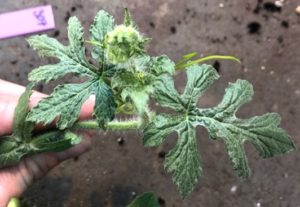
Figure 5. Watermelon 2 weeks after treatment. Leaves are deeply lobed with a puckering, bubble-like texture.
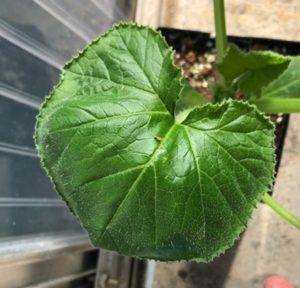
Figure 6. Summer squash 2 weeks after treatment. Leaf edges are curved downward toward the ground.
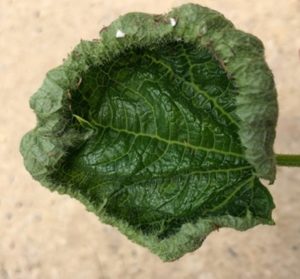
Figure 7. Cucumber 2 weeks after treatment. Leaf is cupped and the bottom edges of the leaf are curved upward towards the top leaf surface.
Summer squash and cucumber, however, show leaf cupping when injured. In summer squash, the top edges of the leaf curve downward towards the ground (Figure 6). The foliage of cucumber tends to curve the bottom edges upward toward the top surface of the leaf, although both directions of cupping were observed. (Figure 7).
On-Going Research at Rutgers
This summer, Rutgers researchers will select a few of these crops to take yield in a field-based dicamba drift study that tests different drift rates and application timings. Although this study gives some preliminary information, more detailed studies are necessary to confirm these findings. However, in the meantime, this greenhouse work gives us a brief snapshot of which species to be most concerned with when working near dicamba treated fields and provides help with field identification of these injury symptoms.
If you suspect that dicamba drift may have injured your crops, please contact you local county extension agent or Rutgers weed science specialist (Dr. Thierry Besançon) as soon as possible, and take detailed pictures of the observed damages.
Early-season Phytophthora blight control in pepper
Phytophthora blight typically develops in low-lying areas after a heavy rain and can spread quickly throughout the entire field. Fortunately, this spring in New Jersey has been really dry – too dry thus far, but that does not need you don’t need to prepare for potential phytophthora issues down the road. This is particularly important if are in fields with a known history of Phytophthora blight. Although the extended period of dry weather works against Phytophthora development, it can lead to Rhizoctonia root rot issues in newly transplanted plugs.
Cultural Recommendations
In general, planting on a ridge or raised, dome-shaped bed will help provide better soil drainage. In fields with known low-lying or wet areas, avoid transplanting in those areas all together. In fields with a known history of Phytophthora blight, plant ONLY resistant cultivars to help reduce plant losses. If mefenoxam-insensitivity is known to exist in a field/farm, plant only tolerant cultivars. Do not apply mefenoxam or metalaxyl in fields where insensitivity is known to exist.
[Read more…]
